vatican

Pope Francis met Meriam Ibrahim, the Christian woman spared a death sentence for apostasy in Sudan, at the Vatican on Thursday after she was flown to Rome by the Italian government following a vigorous international campaign to free her.
Ibrahim, 27, was accompanied by her husband Daniel Wani and two young children when she met Francis for nearly half an hour at his Santa Marta residence.
The audience was arranged only hours after she disembarked at Rome’s Ciampino Airport with her family on an official Italian aircraft. She was smiling as she carried baby Maya, who was born just two months ago as Ibrahim was shackled in prison.
The pope thanked her for her courage and loyalty to her Christian faith despite facing threats of execution in an ordeal that lasted nearly a year.
The Vatican’s chief spokesman, the Rev. Federico Lombardi, said Francis wanted Thursday’s meeting to be a “gesture of support for all those who suffer for their faith, or living in situations of difficulty or restraint.”
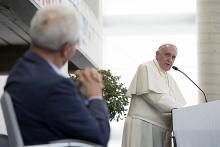
Pope Francis sought forgiveness for decades of persecution of Italian Pentecostals when he met with around 300 evangelicals from the U.S., Argentina, and Italy in the southern town of Caserta on Monday.
The pope made his second visit in as many days to the Mafia stronghold near Naples, this time to meet evangelical pastor Giovanni Traettino, whom he befriended while he was archbishop of Buenos Aires.
During the visit, Francis apologized for the persecution suffered by Pentecostals under Italy’s fascist regime in the 1920s and 1930s and urged Christians to celebrate their diversity and unity.
“Catholics were among those who persecuted and denounced the Pentecostals, almost as if they were crazy,” Francis said.
“I am the shepherd of the Catholics and I ask you to forgive my Catholic brothers and sisters who did not understand and were tempted by the devil.”
Since his election last year, the pope has been reaching out to other faiths and has held talks with Protestant, Jewish, and Muslim leaders. On Monday, he went even further by apologizing for what Catholics had done.
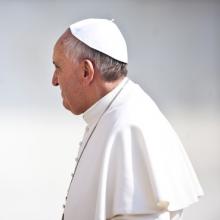
It began with the murder of an innocent 3-year-old boy who burned to death in his grandfather’s car in a Mafia ambush in January. Pope Francis was so shaken by the death of Nicola “Coco” Campolongo that he spoke out against the ferocity of the crime and those behind it.
“They are not with God,” Francis said during his visit to the nearby town of Sibari in the region of Calabria where the global crime syndicate ‘Ndrangheta is based. “They are excommunicated!”
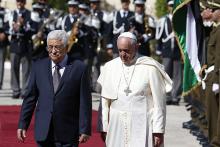
As Israel continued its ground offensive into the Gaza Strip, Pope Francis urged Israeli President Shimon Peres and Palestinian President Mahmoud Abbas to end the spiraling conflict.
The pontiff telephoned the two leaders on Friday to express “his very serious concerns” only six weeks after both me joined him at the Vatican for an historic prayer meeting.
Francis said he was concerned about the “climate of growing hostility, hatred, and suffering” that was claiming many victims, resulting in “a serious humanitarian emergency”, the Vatican said in a statement.
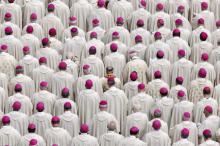
Pope Francis has provoked a debate within the Catholic Church after being quoted as saying that one in 50 Catholic clerics is a pedophile.
In the latest example of his get-tough stance against sex abuse — and his signature style of frank answers to tough questions — the pope told the Italian daily La Repubblica that the sexual abuse of children was like “leprosy” in the church and he pledged to “confront it with the severity it requires.”
But the exclusive interview with 90-year-old veteran journalist Eugenio Scalfari published Sunday drew an immediate reaction from the Vatican that disputed the accuracy of the pontiff’s quotes.
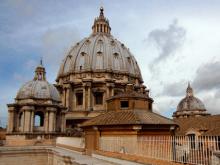
Pope Francis’ promised reforms of the Vatican bureaucracy are starting to take shape, with new leaders appointed to oversee the troubled Vatican bank and plans to overhaul the Catholic Church’s approach to global communications.
Six new lay members, including Mary Ann Glendon, a former U.S. ambassador to the Holy See and Harvard law professor, will join the bank’s board.

Profits plunged by more than $100 million at the Vatican bank last year after thousands of accounts were shut down in a radical overhaul of the scandal-scarred institution.
In its 2013 annual report released Tuesday, the bank, officially known as the Institute for Religious Works, said its net profit totaled 2.9 million euros ($3.9 million) last year, a dramatic drop from the 86.6 million euros ($117.8 million) it reported in 2012.
The bank said the slump was due to extraordinary expenses, losses related to externally managed investment funds and fluctuations in the price of gold.
Losses included a controversial $20.5 million loan granted to a production company owned by a friend of Cardinal Tarcisio Bertone, the former Vatican secretary of state who has faced criticism for mismanagement as the church’s No. 2 official under retired Pope Benedict XVI.

Pope Francis on Monday held his first meeting with victims of clergy sex abuse, begging for forgiveness and promising to hold “accountable” the bishops who were complicit in covering up for predatory priests.
“Before God and his people I express my sorrow for the sins and grave crimes of clerical sexual abuse committed against you. And I humbly ask forgiveness,” the pope said, according to a Vatican transcript of his morning homily.
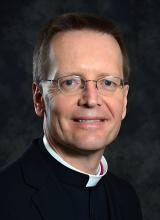
Despite numerous controversies over dismissing gay Catholics from church posts and the U.S. hierarchy’s campaign against same-sex marriage, Catholic leaders have carefully, if quietly, avoided doing anything to block gay couples from having their children baptized.
But a move by a bishop in Wisconsin to route all such decisions through his office is raising questions about whether that neutral zone will now become another battleground, and whether the growing acceptance of gay parents will inevitably draw more attention to this practice and force church leaders to establish clearer rules.
The default position for most bishops — reiterated in a major Vatican document released on Thursday — is that if the parents pledge to raise the child Catholic, then no girl or boy should be refused baptism.

Faced with a cultural landscape that’s shifting faster than the church’s ability to keep up, Catholic bishops are looking for new approaches toward unmarried couples, divorced people, and single parents who are disillusioned with the church.
The first-ever survey of 114 bishops’ conferences around the world found that many Christians “have difficulty” accepting church teachings on key issues such as birth control, divorce, homosexuality, and cohabitation.
But one senior church leader cautioned that “the doctrine of the church is not up for discussion.”
The survey’s findings, released in a 75-page document by the Vatican on Thursday, will serve as the blueprint for October’s Synod of Bishops, when bishops from around the world will gather to discuss issues facing the family.

The day before a newly-elected Pope Francis was to be formally installed at the Vatican in 2013, Cardinal Theodore McCarrick was celebrating Mass in St. Peter’s Basilica when he passed out at the altar and had to be rushed to the hospital.
It was a scary moment, and especially odd to see McCarrick stricken; even at 82, the energetic former archbishop of Washington always had a reputation as one of the most peripatetic churchmen in the Catholic hierarchy.
Doctors in Rome quickly diagnosed a heart problem – McCarrick would eventually get a pacemaker – and the cardinal was soon back at his guest room in the U.S. seminary in Rome when the phone rang. It was Francis. The two men had known each other for years, back when the Argentine pope was Cardinal Jorge Bergoglio, archbishop of Buenos Aires. McCarrick assured Francis that he was doing fine.
“I guess the Lord isn’t done with me yet,” he told the pope.
“Or the devil doesn’t have your accommodations ready!” Francis shot back with a laugh.

Top Catholic and Orthodox church officials in North America are calling on the Vatican to let married men become priests in Eastern rite Catholic churches, another sign that optional celibacy could become a front-burner issue under Pope Francis.
Like Eastern Orthodox churches, Eastern rite Catholics tend to have more local autonomy than their Roman Catholic counterparts, and they have particular liturgies and customs that date back to their origins in the Middle East and Eastern Europe.
One of those customs is optional celibacy. While Eastern rite Catholic bishops cannot be married, the priesthood is open to married men.

Pope Francis dived into the Middle East peace process on Sunday, urging the Israeli and Palestinian presidents to act with courage and end what he called the “spiral of hatred and violence” during a historic prayer meeting at the Vatican.
The Middle East leaders were joined by the Ecumenical Patriarch Bartholomew, spiritual leader of the world’s Eastern Orthodox Christians, and proceeded to the Vatican gardens for a tightly orchestrated 90-minute ceremony that was notable for the absence of any religious symbols.
Earlier, in St. Peter’s Square, a handful of protesters waved Palestinian flags in a bid to send a stronger political message to what the Vatican previously described as a “pause from politics.”
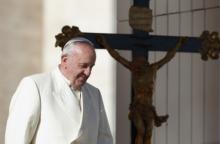
Pope Francis has been working nonstop since his election more than a year ago, and he has shown remarkable resilience for a 77-year-old confronted with an array of church crises. But he is also fatigued at times and his advisers are hoping that he will take a break this summer.
“We have been asking him to have holidays this year,” Cardinal Oscar Rodriguez Maradiaga of Honduras told reporters during a visit to Washington this week. “Because last year he didn’t and sometimes he’s very tired.”
“So I think that during August he’s going to retire to rest,” said Maradiaga, who heads a kitchen cabinet of eight cardinals from around the world that Francis established as his top advisers.

Pope Francis’ announcement this week that he would meet with victims of sexual abuse by priests is dividing victim advocates, with some dismissing the move as “meaningless” and others endorsing it as a positive step, albeit taken belatedly and under pressure.
“A welcome and overdue change,” said Anne Barrett Doyle of BishopAccountability.org, a prominent activist pushing the Catholic Church to overhaul its policies and practices on clergy abuse.
“Good to hear Pope Francis speak out and meet survivors,” tweeted Marie Collins, an abuse victim whom Francis named to a Vatican commission to promote reforms, on hearing that the pope compared clergy abuse to a priest celebrating a black Mass.
But others said Francis’ first-ever encounter with victims — and his pledge for “zero tolerance” for abusive clerics of any rank — was simply stagecraft aimed at distracting the public from what they say are the pope’s larger failures to address the abuse crisis.
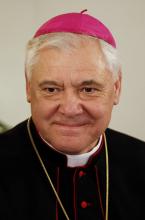
The American nuns who were publicly scolded by the Vatican’s top doctrinal official for disobedience and promoting unorthodox beliefs have rejected the criticisms, and say their “attempts to clarify misperceptions have led to deeper misunderstandings” between Rome and the organization representing most of the 50,000 sisters in the U.S.
“It was not an easy discussion, but its openness and spirit of inquiry created a space for authentic dialogue and discernment,” the four sisters representing the LCWR said late Thursday.
“This work is fraught with tension and misunderstanding,” they said. “Yet, this is the work of leaders in all walks of life in these times of massive change in the world.”
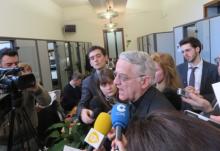
The Vatican issued an urgent appeal Thursday for the release of more than 200 Nigerian schoolgirls kidnapped by the Islamist militant group Boko Haram.
“The denial of any kind of respect for life and for the dignity of human beings, even the most innocent, vulnerable and defenseless, calls for the strongest condemnation,” Lombardi said.
He added that the kidnappings aroused the most heartfelt feelings of compassion for the victims and a sense of horror for the physical and spiritual suffering and the incredible humiliation they have suffered.

The Vatican has effectively addressed the “worldwide scourge” of clerical sexual abuse over the past decade and promoted the reporting of allegations to both church and legal authorities, a United Nations panel heard on Tuesday.
Tomasi faced intense questioning from members of the U.N. committee investigating whether the church upholds the U.N. convention against torture beyond the walls of the world’s smallest country, the Vatican City state.

Catholic nuns in the U.S. have been thumbing their nose at Rome’s demands to toe the doctrinal line and they need to obey or face serious consequences, the Vatican’s enforcer of orthodoxy said in a surprisingly tough talk to women representing most American sisters.
Mueller said the LCWR — which represents about 80 percent of the more than 50,000 Catholic nuns in the U.S. – is dependent on the Vatican for its bona fides as a church body. He indicated that the group’s status, and the Catholic faith of the sisters, was at risk if they did not heed Rome’s directives.
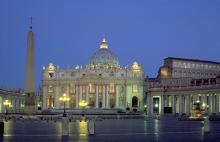
The Vatican could face a wave of new sexual abuse claims dating back decades if a United Nations inquiry finds that the Roman Catholic Church has violated an international treaty against torture and inhuman treatment.
“For too long, sexual violence and acts of rape by the Catholic Church have been minimized,” said Katherine Gallagher, senior staff attorney at the New York-based CCR, after the U.N. panel that enforces the torture convention held hearings in Geneva.